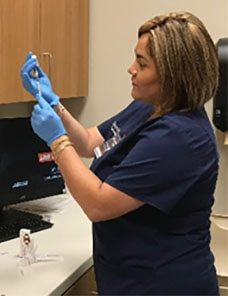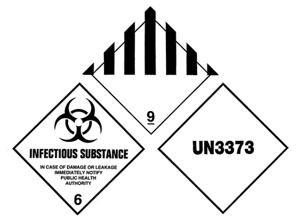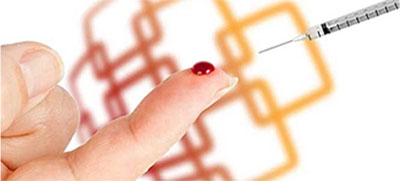Clinical Safety Program
 Individuals working in a clinical environmental may potentially become exposed to a variety of biological, chemical, and physical hazards during the course of their routine work-related duties. The Clinical Safety Program under the Department of Environmental Health, Safety and Risk Management (EHSRM) oversees and coordinates efforts to maintain a safe work environment at all UTRGV clinics, hospital settings and clinical teaching environments. The Clinical Safety Program serves a variety of programs and schools including the School of Medicine, Physicians Assistants, Nursing, Clinical Laboratory Science Programs and Health Services as well as over twenty clinics distributed throughout the Rio Grande Valley.
Individuals working in a clinical environmental may potentially become exposed to a variety of biological, chemical, and physical hazards during the course of their routine work-related duties. The Clinical Safety Program under the Department of Environmental Health, Safety and Risk Management (EHSRM) oversees and coordinates efforts to maintain a safe work environment at all UTRGV clinics, hospital settings and clinical teaching environments. The Clinical Safety Program serves a variety of programs and schools including the School of Medicine, Physicians Assistants, Nursing, Clinical Laboratory Science Programs and Health Services as well as over twenty clinics distributed throughout the Rio Grande Valley.
The program consists of extensive training that familiarizes stakeholders with the hazards associated with their workplace, routine surveillance to ensure compliance with applicable rules and regulations in a healthcare environment and emergency response procedures to ensure that personnel are familiar with the procedures in the event of an accident such as a workplace exposure.
UTRGV Program Documents
Training Requirements
Initial Clinical Safety Training
Persons in a clinical environment are potentially exposed to both chemical and biological agents through the course of their routine work-related duties. Federal and State Law (Texas Hazard Communication Standard TH&S Code 502.009) require that anyone who works with hazardous chemicals attend Hazard Communication training prior to beginning work. The OSHA Bloodborne Pathogens Standard (29 CFR 1910.1030 ) requires that all employees who are potentially exposed to infectious biological agents attend Bloodborne Pathogen training within 30 days of their employment.
The Clinical Safety Training course combines both mandates and is offered in a classroom format as well as online. Information regarding the training can be found at the following website:
In addition to providing useful information regarding exposure to hazardous substances and biological agents, the training classes offer very useful information regarding how to obtain a Safety Data Sheet, how to dispose of hazardous waste, and what to do in the event of an emergency.
Annual Bloodborne Pathogens Refresher Training
This training is available online only and will provide a brief refresher on the critical elements of laboratory safety and also fulfill the annual bloodborne pathogens training requirement. Principle investigators and laboratory personnel working in or overseeing a clinical laboratory are required to complete this convenient on-line training. This online training module can be accessed at the following link:
Supervisors and Principal Investigators will be responsible for verifying that all laboratory personnel have completed the training. Environmental Health, Safety and Risk Management will be verifying training records during routine surveys.
Infectious Shipping Training - Required for those that use E-Ship Global
 Shipping of Biological Substances and Dry Ice: In order to comply with U.S. Department of Transportation (DOT) and International Air Transportation Association (IATA) Dangerous Goods Regulations, persons who prepare hazardous materials for shipment (including shipping papers) or who transport hazardous materials in commerce must complete training in accordance with the requirements of these transportation safety authorities. Biological Materials and Dry Ice Shipping training is required if an employee performs any of the following functions:
Shipping of Biological Substances and Dry Ice: In order to comply with U.S. Department of Transportation (DOT) and International Air Transportation Association (IATA) Dangerous Goods Regulations, persons who prepare hazardous materials for shipment (including shipping papers) or who transport hazardous materials in commerce must complete training in accordance with the requirements of these transportation safety authorities. Biological Materials and Dry Ice Shipping training is required if an employee performs any of the following functions:
- Packages or ships human or animal clinical specimens or tissues
- Packages or ships any human or animal clinical specimens as part of a study where the sponsor has designated these materials as Category B biological substances (or prepare paperwork for such packages)
- Packages or ships any materials that may contain an agent infectious to humans or animals (i.e., microbiological cultures).
Once initial training is completed, the person must complete refresher training at least once every 24 months or when significant regulatory changes occur.
Infectious Shipping Training can be arranged by notifying the following EHSRM staff member:
Javier Garcia, RN
EHS Program Manager
EREBL 1.322
(956) 665-2052
Javier.Garcia1@utrgv.edu
Bloodborne Pathogen Exposure (Early Reporting is Crucial!)
 Bloodborne pathogens are infectious microorganisms in human blood that can cause disease in humans. These pathogens include, but are not limited to, hepatitis B (HBV), hepatitis C (HCV) and human immunodeficiency virus (HIV). Needlesticks and other sharps-related injuries may expose workers to bloodborne pathogens.
Bloodborne pathogens are infectious microorganisms in human blood that can cause disease in humans. These pathogens include, but are not limited to, hepatitis B (HBV), hepatitis C (HCV) and human immunodeficiency virus (HIV). Needlesticks and other sharps-related injuries may expose workers to bloodborne pathogens.
Exposure incidents (needlestick; mucous membrane exposure) should be reported immediately to your supervisor and to a medical professional within two hours for immediate medical evaluation, and if necessary intervention to mitigate the risk of acquiring an infectious disease. Download the following file and post it where it can be readily available in the event of an exposure. This document contains specific instructions on what to do in the event of an exposure and the medical clinics that can be visited.
